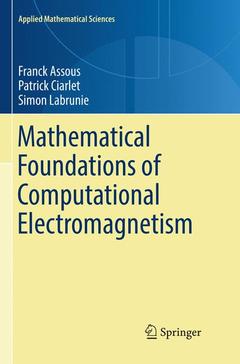Mathematical Foundations of Computational Electromagnetism, Softcover reprint of the original 1st ed. 2018 Applied Mathematical Sciences Series, Vol. 198
Auteurs : Assous Franck, Ciarlet Patrick, Labrunie Simon

This book presents an in-depth treatment of various mathematical aspects of electromagnetism and Maxwell's equations: from modeling issues to well-posedness results and the coupled models of plasma physics (Vlasov-Maxwell and Vlasov-Poisson systems) and magnetohydrodynamics (MHD). These equations and boundary conditions are discussed, including a brief review of absorbing boundary conditions. The focus then moves to well?posedness results. The relevant function spaces are introduced, with an emphasis on boundary and topological conditions. General variational frameworks are defined for static and quasi-static problems, time-harmonic problems (including fixed frequency or Helmholtz-like problems and unknown frequency or eigenvalue problems), and time-dependent problems, with or without constraints. They are then applied to prove the well-posedness of Maxwell?s equations and their simplified models, in the various settings described above. The book is completed with a discussion of dimensionally reduced models in prismatic and axisymmetric geometries, and a survey of existence and uniqueness results for the Vlasov-Poisson, Vlasov-Maxwell and MHD equations.
The book addresses mainly researchers in applied mathematics who work on Maxwell?s equations. However, it can be used for master or doctorate-level courses on mathematical electromagnetism as it requires only a bachelor-level knowledge of analysis.
Presents extensive treatment of the time-dependent equations
Includes the foundations of the analysis of the numerical schemes and computational methods
Uses only the “classical” formulation of electromagnetism (i.e. gradient, divergence and curl operators) avoiding the “intrinsic” formulations based on differential geometry
Date de parution : 01-2019
Ouvrage de 458 p.
15.5x23.5 cm
Date de parution : 06-2018
Ouvrage de 458 p.
15.5x23.5 cm
Thèmes de Mathematical Foundations of Computational Electromagnetism :
Mots-clés :
Maxwell equations; Vlasov Maxwell model; Vlasov Maxwell equation; Vlasov Maxwell system; Magnetohydrodynamics; electromagnetic Darwin model; Helmholtz decomposition; electrostatic problem; magnetostatics; magnetostatic field problem; time harmonic electromagnetic fields; Vlasov Poisson systems; Vlasov Poisson equation; linear Vlasov equation



